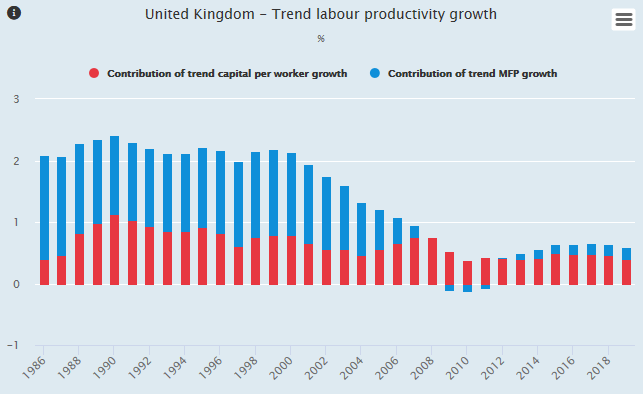Productivity Profile of the United Kingdom
 Organisations
Organisations
Bank of England (BoE): Research of the Bank of England underpins the Bank’s policy activities on subjects relevant to its core duties, including monetary and financial stability.
Office for Budget Responsibility *OBR): The Office for Budget Responsibility is an official independent fiscal watchdog and provides analysis of the UK’s public finances, including 1) economic and fiscal forecasting; 2) evaluating performance against targets; 3) sustainability and balance sheet analysis; 4) evaluation of fiscal risks; 5) scrutinising tax and welfare policy costing.
 Selected Publications
Selected Publications
Bank of England: The impact of COVID-19 on productivity (2020), The empirics of granular origins: some challenges and solutions with an application to the UK (2019), Trend and cycle shocks in Bayesian unobserved components models for UK productivity (2019), The Brexit vote, productivity growth and macroeconomic adjustments in the United Kingdom (2019), International trade, non-trading firms and their impact on labour productivity (2019), The UK’s Productivity Problem: Hub no Spokes (2018);
OECD: Economic Surveys United Kingdom (multiple), COVID-19, productivity and reallocation: Timely evidence from three OECD countries (2021), The impact of COVID-19 on corporate fragility in the United Kingdom: Insights from a new calibrated firm-level Corporate Sector Agent-Based (CAB) Model (2021), Firm investments in skills and capital in the UK services sector (2021), What drives firm and sectoral productivity in the United Kingdom and in selected European countries? (2020), The UK Productivity Puzzle through the Magnifying Glass: A Sectoral Perspective (2018);
Office for National Statistics (ONR): Firm-level labour productivity measures from the Annual Business Survey (2022), Public service productivity (2022), Productivity overview (2021), Management practices, homeworking and productivity during the coronavirus (COVID-19) pandemic (2021), Investment in intangible assets in the UK (2021), Technology intensity and homeworking in the UK (2020), Which Occupations are at Highest Risk of Being Automated? (2019), Public Service Productivity: total, UK, 2016 (2019), Experimental Estimates of Investment in Intangible Assets in the UK: 2015 (2018), Information and Communication Technology Intensity and Productivity (2018);
National Institute of Economic and Social Research: Covid-19 and Productivity: Impact and Implications (2022), Rising Pay Increases to Pressure Bank of England (2022), Productivity and Levelling Up (2022), How to not miss a productivity revival again (2021), Regional disparities in labour productivity and the role of capital stock (2020), Is the UK Productivity Slowdown Unprecedented? (2020).
 Data
Data
Click here to access our Compare-Your-Country tool and explore productivity data from the GFP member countries.

 Latest OECD Recommendations
Latest OECD Recommendations
- Regional spending should be targeted, notably on infrastructure and housing
- In particular, invest in improving inter- and intra-city transport links where such investments can foster agglomeration effects and unlock related productivity benefits;
- Continue to increase direct and indirect support for private and public R&D, and for the collaboration between businesses and universities to promote applied innovations and their diffusion
- Improve the skills of workers
- By allowing for more freedom to adapt technical education to local business needs;
- By increasing the financing for – and continue to promote the effectiveness of – active labour market policies for youth who are neither in employment nor in education or training;
- Introduce individually targeted programmes for low-wage and low-skilled workers to improve their lifelong learning opportunitiesIntroduce individually targeted programmes for low-wage and low-skilled workers to improve their lifelong learning opportunities.
Related Documents


